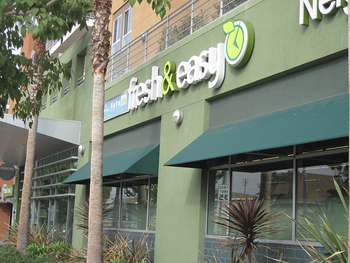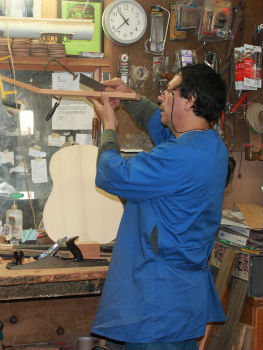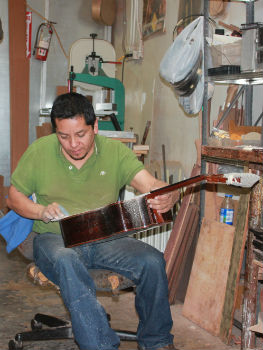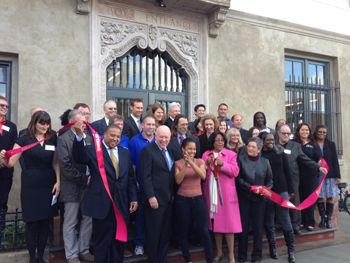By David Rapkin
Editor’s note: The Crenshaw meeting was held Tuesday, December 11, 2012
Last night’s parent meeting at Crenshaw High School was one of the most inspiring exercises in speaking truth to power that I have witnessed in a long time.
The Crenshaw library was packed to overflowing with parents, students, Crenshaw teachers and community members, as well as a large contingent of UTLA activists from the Harbor to the Valley. From the moment Crenshaw’s principal started the meeting with a transparently disingenuous powerpoint, you could feel the anger, and our power, in the room.
A painful chunk of the meeting was taken up by Crenshaw principal Remon Corley and District bigwigs such as LAUSD Superintendent Office Director George Bartleson and Magnet Director Estelle Luckett trying to explain their shameless attempt to reconstitute Crenshaw and convert it to magnets, as if their naked power grab were a thoughtful move to help students and the community. They tried everything from absurd bar graphs “comparing” Crenshaw’s SLCs to district magnets in upper-middle class neighborhoods to pretending that last night’s rigged meeting about a virtual done-deal takeover was simply “an opportunity” for the community to choose their school’s future direction.
Unfortunately for the suits, absolutely no one was buying the bill of goods they were trying to sell.
Once parents got started and seized the floor, 12 parents in a row spoke, including several in Spanish, to issues of the need for continuity and stability at the school, praise for last year’s reform work, calls for real inclusion and for funding. Then it was the students’ turn to bring down the house.
Perhaps one of the most telling moments of the whole night came late in the meeting when Bartleson from the District claimed for the fiftieth time that the “magnet conversion” would bring new resources to the school. A very articulate parent shot back: “if you guys have all these resources, why have you been keeping them from our school all these years? Where have they been all along?”
Again and again, parents and students took the floor (when the brass shut up long enough to give them time to speak) to express their outrage at the fact that District moves to convert the school have happened with no consultation and no discussion with the school community, despite our side’s multiple attempts to engage the District in discussions.
The teachers in the room were angry yet restrained, and let it be the parents’ and students’ space, as was the plan.
It was clear from this excellent balance that the meeting was planned and organized through patient leadership development, through many meetings, and after much democratic planning, strategizing, and sharing of ideas and putting them into action. The way parents and students worked together and led the meeting, with back-up from teachers, represents the kind of work that UTLA urgently needs to invest institutional resources into right now, the kind of organizing that may happen at a few schools because of the organizers who happen to be there, but that needs to happen across the District through a massive infusion of union resources into organizing. It is fantastic that the UTLA officers are helping tremendously with the Crenshaw fight; now they need to use the resources that only they control to reproduce that power at all our schools.
Last night’s meeting reminded all of us how exciting it would be if UTLA really worked with our community partners to wage this fight everywhere.
There were moments when you almost felt sorry for the six-figure District people. Luckett, the Magnet Director, struggled to get a hearing on the strength of the argument that she too “looked like the students at Crenshaw” and lived right in the community. Unfortunately for her, the actual community members knew that whatever she looks like and wherever she came from and wherever she lives, last night her job was to front for the absent “Dr.” John Deasy and his unilateral decision to re–make Crenshaw in his own image. Deasy’s plan to make Crenshaw’s entire staff re-apply for their jobs and to squander years of tremendously successful, collaborative reforms at the school only “works” if he gets parents, students and teachers at Crenshaw to acquiesce and do what he says.
From the looks of things, that’s going to be a tall order. The Crenshaw community is united in the conviction that the authentic, home-grown, foundation-backed reforms that Crenshaw has been engaging for the past two and a half years represent by far the best course for the school. Everyone knows that Deasy’s phony “concern” for the Crenshaw community, and the fake, half-baked “reform” ideas he pulled out of who-knows-where to impose on the school, are little more than his attempt to punish the entire Crenshaw community for daring to do something meaningful and for daring to organize from the grassroots. Deasy quite clearly isn’t about helping schools; his goal is to control schools and weaken their independence, at all costs.
And our goal is to fight back with all our collective strength and to force the powers that be to fully fund our schools and allow all of us to run them democratically and collectively in the interests of our entire communities. Last night’s meeting was a very important step in this direction.
David Rapkin teaches at Youth Opportunities Unlimited Alternative High School in South LA and is a member of PEAC (Progressive Educators for Action)
To read the Los Angeles Times story about the Crenshaw meeting, click here.









 For many shoppers around LA, “Thank you for shopping at Fresh & Easy” has become a familiar sound.
For many shoppers around LA, “Thank you for shopping at Fresh & Easy” has become a familiar sound.








